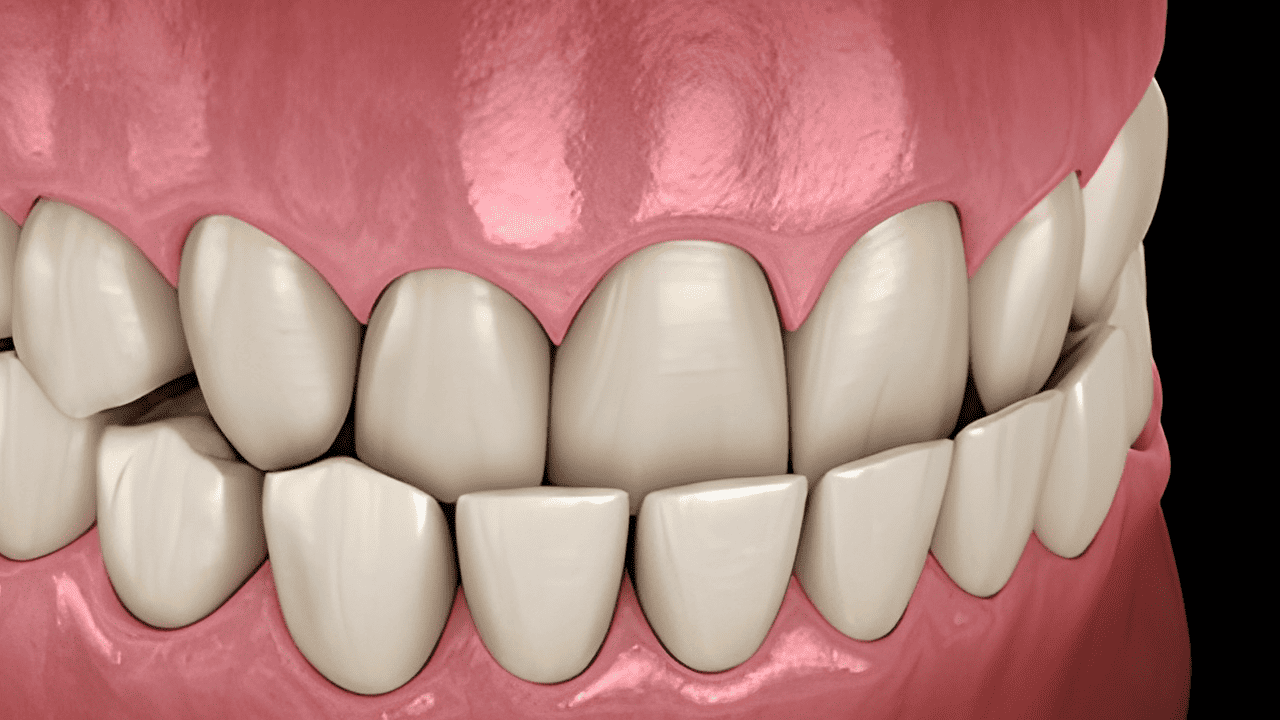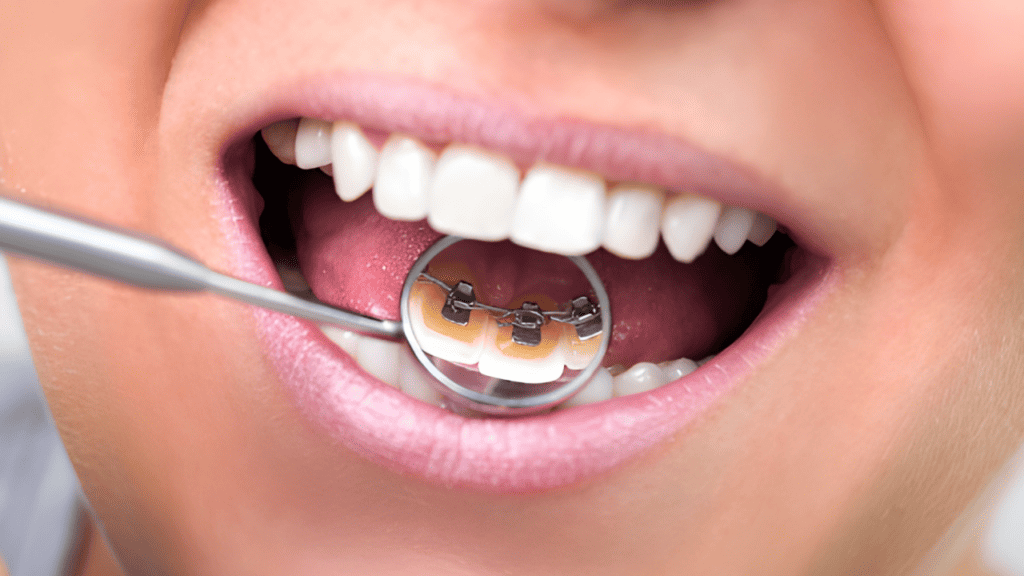One dental term that comes up quite frequently is “underbite.” Despite its common occurrence, many are unaware of how it happens in the first place or how it actually affects your oral health. In this blog, you will learn everything you need to know about underbites.
What Is an Underbite?
An underbite, or prognathism, is a dental condition where the lower teeth stick out further than the upper teeth when the mouth is closed. It is considered a dental (teeth) or skeletal issue, or both.
The normal configuration of the jaw is a slight overlap of the upper teeth over the lower teeth. But this alignment is reversed in an underbite, with the lower teeth being more prominent. This may appear to be a trivial detail, but it’s far from it. An underbite can significantly affect a person’s oral health, facial appearance, and even quality of life.
Now, before we proceed further, it’s crucial to understand that an underbite is not just a cosmetic issue. It’s a condition that affects the functionality of the jaw and can lead to other serious health problems if left untreated.
Underbite Vs Overbite
Now, let’s move on to overbites. Overbites and underbites are often mixed up due to their similar names, but they are quite different. In an overbite, it’s the upper teeth that extend too far over the lower teeth. It’s essentially the reverse of an underbite.
As we mentioned before, your upper teeth should fall right over your bottom teeth. So what is the difference between normal teeth and an overbite? The misalignment of the upper teeth causes an overbite, and it makes the upper teeth protrude out past the front teeth more than normal. If there is a significant gap between the upper and lower teeth, then that is a key sign of an over bite.
An overbite can be just as problematic as an underbite. Both of these conditions can result in discomfort, difficulty in performing daily tasks such as eating and speaking, and even health issues if not addressed. However, their treatment approaches differ, given the distinctive nature of the misalignments.
Underbite vs Crossbite
Another condition that is often confused with an underbite is a crossbite. A crossbite occurs when some upper teeth sit inside the lower teeth when the mouth is closed, which is not the standard alignment.
This misalignment can happen on one side (unilateral crossbite) or both sides (bilateral crossbite) of the mouth. The significant distinction here is that while an underbite affects all the front teeth, a crossbite can affect a single tooth or a group of teeth.
Just like underbites and overbites, crossbites can lead to complications if left uncorrected. These include uneven tooth wear, gum disease, and potential changes to the face and jawline over time.
What Causes an Underbite?
Several factors can contribute to the development of an underbite. Predominantly, underbites are the result of genetics. If your parents or grandparents had an underbite, it’s possible that you could inherit it. This hereditary link makes underbites a common occurrence within certain families.
Aside from genetics, certain behaviors during early childhood can also influence the development of an underbite. These include prolonged use of a pacifier, habitual thumb-sucking, or tongue thrusting. Each of these habits can potentially affect the alignment of the teeth and jaw, leading to an underbite.
In some rare cases, an underbite can be the result of a jaw injury or the presence of a tumor in the jaw. These situations can alter the structure and function of the jaw, leading to an underbite.
Is It Ok to Have an Underbite?
Now, one might wonder, “If I have an underbite, is it really a problem?” It’s essential to note that everyone is unique, and so is their experience with an underbite. Some people with an underbite may not experience any discomfort or health complications. However, others may face challenges that range from mild to severe.
An underbite can lead to difficulties in basic functions such as speaking and eating. It can also cause problems with breathing, particularly during sleep, leading to conditions like sleep apnea. Additionally, the misalignment of teeth can result in uneven wear and tear, which increases the risk of tooth decay and gum disease.
Over time, this can also lead to chronic pain in the jaw, head, or neck. Therefore, while some people may not experience any immediate problems, it’s always advisable to consult with a dental professional if you have an underbite.
An untreated underbite can lead to bite problems and the chipping or fracturing of teeth since the jaw is misaligned. Therefore, an underbite can lead to both functional and cosmetic problems.
What are the negatives effects of an Underbite?
There can be several negatives associated with an underbite. For starters, an underbite can make basic daily tasks challenging. The misalignment can interfere with proper chewing and speech, making eating and talking difficult. This can affect a person’s social life and lead to self-consciousness or anxiety in public settings.
The uneven wear on the teeth caused by an underbite can also lead to a greater likelihood of tooth decay and gum disease. This is because the misaligned teeth can be harder to clean effectively, leading to a buildup of plaque and bacteria.
Over time, untreated underbites can also lead to chronic jaw pain and headaches due to the constant strain on the jaw muscles. This discomfort can affect a person’s quality of life, making everyday activities like eating or even smiling painful.
Lastly, for many, the most significant negative of an underbite is the effect it can have on their facial appearance and self-esteem. It is often associated with a “bull-dog” appearance. Many people with underbites feel self-conscious about their looks, which can impact their confidence and mental health.
Do Underbites Get Worse With Age?
The progression of an underbite can vary from person to person. However, like many health conditions, underbites can worsen with age if left untreated. As a person ages, the ongoing pressure and wear on the teeth and jaw can lead to further misalignment. This can result in an increase in discomfort, difficulty in performing daily functions, and potentially even more serious health issues.
Over time, untreated underbites can also lead to changes in facial structure, altering a person’s appearance. This is due to the constant protrusion of the lower jaw, which can affect the shape and symmetry of the face.
How Do You Get Rid of an Underbite?
The treatment for an underbite will depend on its severity and the specific needs of the individual. For mild underbites, non-surgical treatments like braces or clear aligners may be sufficient.
These devices work by gradually shifting the teeth into proper alignment over time.
In more severe cases, corrective jaw surgery may be necessary. This procedure, also known as orthognathic surgery, involves surgically repositioning the jaw to correct the alignment. This is usually a last-resort treatment option when non-surgical methods are insufficient.
It’s important to note that treatment for an underbite often involves a team of dental professionals, including an orthodontist and an oral and maxillofacial surgeon. In the case of children, early intervention is key. Pediatric dentists can often detect signs of an underbite and can work with orthodontists to implement preventative measures, possibly avoiding the need for surgery in the future.
In addition to these traditional methods, newer treatments are also becoming available. For instance, some dental professionals are now using devices called mandibular advancement devices (MADs) to treat underbites. These devices, which are similar to mouthguards, work by pushing the lower jaw forward to improve alignment.
Remember, it’s crucial to consult with a dental professional or orthodontist to discuss your options and determine the best course of action. There is no one-size-fits-all solution, and what works best will depend on the specifics of your underbite and your overall health.
Can Removing Teeth Fix an Underbite?
In certain situations, tooth extraction may be part of the treatment plan for an underbite. This is generally the case when there is overcrowding in the mouth, and extra space is needed to realign the teeth properly.
However, it’s important to understand that tooth extraction alone usually won’t solve an underbite. It’s typically part of a larger treatment plan that could include braces or aligners.
Tooth extraction for underbite correction is not a decision to be taken lightly. It’s a surgical procedure that comes with its own risks and recovery process. Therefore, it should only be considered under the guidance of a dental professional who can assess whether the benefits outweigh the risks in your specific situation.
Keep in mind, modern orthodontics has made great strides, and non-extraction methods are often preferred. The goal is always to preserve as much of your natural dental structure as possible.
Conclusion
In conclusion, an underbite is not just a distinctive facial feature. It’s a dental condition that can have far-reaching implications for both oral and overall health. Understanding the ins and outs of underbites, from what they are to how they’re treated, is the first step towards managing this condition effectively.
Whether you have an underbite yourself or know someone who does, it’s important to recognize the signs and seek professional advice if necessary. An underbite might not seem like a significant concern initially, but leaving it untreated could lead to more severe health problems in the future.
WebMD
Healthline
Everything You Need to Know About Treating an Underbite
Jacobus Orthodontics
What is an Underbite and How Can it Be Corrected?
Weiss Ortho
Overbite vs Underbite: the Similarities and Differences by Harris & Ward
Erica Anand is a certified dental expert. She holds a BA in Chemistry and a Doctorate of Dental Surgery from Stony Brook University. After completing a two-year pediatric dentistry program, she now runs a private practice focusing on preventive dentistry and is a member of the American Association of Dental Consultants.
Marcus Ramsey has been a professional writer for over seven years. He has talked about and produced content for industries like Dentistry, Healthcare, and more.






